Abstract
Apiculate yeasts of the genus Hanseniaspora/Kloeckera are the main species present on mature grapes and play a significant role at the beginning of fermentation, producing enzymes and aroma compounds that expand the diversity of wine color and flavor. Ten species of the genus Hanseniaspora have been recovered from grapes and are associated in two groups: H. valbyensis, H. guilliermondii, H. uvarum, H. opuntiae, H. thailandica, H. meyeri, and H. clermontiae; and H. vineae, H. osmophila, and H. occidentalis. This review focuses on the application of some strains belonging to this genus in co-fermentation with Saccharomyces cerevisiae that demonstrates their positive contribution to winemaking. Some consistent results have shown more intense flavors and complex, full-bodied wines, compared with wines produced by the use of S. cerevisiae alone. Recent genetic and physiologic studies have improved the knowledge of the Hanseniaspora/Kloeckera species. Significant increases in acetyl esters, benzenoids, and sesquiterpene flavor compounds, and relative decreases in alcohols and acids have been reported, due to different fermentation pathways compared to conventional wine yeasts.
1. Introduction
Non-Saccharomyces (NS) yeasts were considered unattractive in traditional winemaking, and sulphites addition was the way to prevent the risk of their growth at the beginning of the vinification process. However, today’s increased knowledge about yeast diversity has demonstrated that there are many NS yeasts with beneficial properties that contribute to increasing the sensory complexity of wines [1,2,3]. The main NS yeasts associated with grapes are the apiculate group with bipolar budding, more precisely, the genus Hanseniaspora and its asexual anamorph Kloeckera [4,5]. In Figure 1, the plating and microscopy characteristics of two species of the genus are shown.
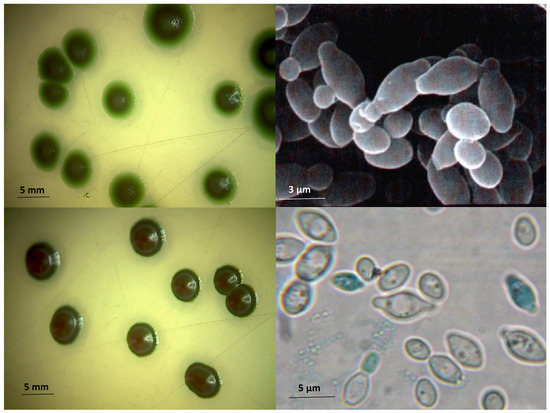
Figure 1.
On the left-hand side are the typical colony color and morphology for Hanseniaspora/Kloeckera strains that are readily differentiated from other yeast genera in WL nutrient agar medium. However, is more difficult to distinguish between species, although some slight differences between H. uvarum (upper) colonies and H. vineae (lower) colonies can be appreciated in these photos. On the right-hand side, H. uvarum is visualized by electron microscopy and H. vineae is visualized with blue methylene stain.
The Hanseniaspora/Kloeckera (H/K) group is currently composed of 10 recognized species associated with grapes [6,7,8]. One of the main characteristics of these species is the weak fermentation capacity compared to Saccharomyces cerevisiae (SC). However, some species, such as “vineae”, might reach about 10% of the alcohol by volume of fermentative capacity under winemaking conditions. Furthermore, these species are important in the production of an increased diversity of volatile compounds in wine, and it was demonstrated the chemical composition of wines made with H/K in combination with SC differ from reference wines [9,10,11,12]. During these early studies about apiculate yeasts, some authors [13,14,15] showed that not all H/K strains formed high levels of volatile acidity and many of them produced similar levels to SC in this regard. These results indicate that although some strains of H/K can provide higher levels of ethanol than other strains, the main characteristic of many of these known strains is the increased formation of some acetate esters. The production of other secondary metabolites—i.e., glycerol, acetaldehyde, and hydrogen sulphide—also differed between strains [16]. Thus, differences in chemical analyses of the wines were noted.
The initial growth of H/K had a retarding effect on the subsequent growth of SC, as also shown for other NS species in mixed cultures [17]. Therefore, when considering the use of H/K strains at winemaking, grape must nutrient composition and competition for assimilable nitrogen by mixed cultures should be understood to prevent sluggish fermentations [18]. Some other cell interactions between H/K strains and SC that inhibit their growth were reported [19], however, H/K strains are intense removers of some vitamins, such as thiamine [20] or calcium pantothenate [21]. Medina et al. [17] found these two vitamins, in combination with ammonium salts, improved the development of SC strains to complete fermentation. Addition of yeast extract at 2 g/L was demonstrated to be more effective for H. vineae utilisation than ammonium salts in agave juice for tequila [22]. In white wine production, a K. apiculata isolate was used with SC at laboratory scale [23]. Inoculation of SC occurred 1 h after K. apiculata, and a dry wine of 13% by volume of ethanol was produced. A positive sensory evaluation of the Sauvignon blanc wines was obtained at 5 and 18 months after production. The production of β-phenylethyl acetate and ethyl acetate by the apiculate yeast H. guilliermondii has been investigated in laboratory fermentations [24]. The β-phenylethyl acetate ester contributes to ‘rose’, ‘honey’, ‘fruity’, and ‘flowery’ aroma nuances, and is formed to a greater or lesser extent by yeasts. As part of the ‘fermentation bouquet’, it can contribute to the overall flavor of a young wine.
The positive oenological characteristics that this H/K confers to wine have been broadly reported [18,25,26]. In addition, some studies have shown that several H/K strains have potential as biocontrol agents against fungi, such as Botrytis. The competition for nutrients is the action mechanism of protection used by H. uvarum against fungi in grapes and apples [27,28].
2. Genetics Context of Hanseniaspora Species
2.1. Application of Molecular Techniques for Taxonomy and Whole Genome Analysis
Classical microbiology techniques have been extensively used in oenology to select and inoculate the best yeast strains for obtaining enhanced positive characteristics in final wines. During the last decades, the use of molecular techniques for the identification and selection of specific strains has proven invaluable for the winemaking industry. Polymerase chain reaction-based methods allow the identification of distinct species and, also, strain genotyping, resulting in a more accurate strain selection [29,30]. Based on this knowledge, culture-independent techniques have been developed to detect microorganisms present during fermentation that are not cultivable by conventional methods [31,32,33]. Among these culture-independent techniques, the development of next-generation sequencing permitted the description of the whole microbiota present in a specific environment, even in complex communities, such as those found throughout the wine fermentation process [34,35].
Hanseniaspora species have been widely detected in various wine-related environments, especially from soil and grapes to the early stages of vinification [36,37]. This genus is part of the apiculate group of yeast formed by Hanseniaspora, Saccharomycodes, and Nadsonia. The genus Hanseniaspora presents heterogeneous morphological, serological, and chemotaxonomic features [38]. Ten species of Hanseniaspora have been recovered from grapes or wines, which are taxonomically associated in two groups (Figure 2): H. valbyensis, H. guilliermondii, H. uvarum, H. opuntiae, H. thailandica, H. meyeri, and H. clermontiae in one cluster; and H. vineae, H. osmophila and H. occidentalis in the other, as revealed by partial sequence alignment of the 26S rRNA gene. The favorable oenological characteristics that this genus confers to wine have been broadly reported [18,25,39]. However, the biotechnological potential of these species is still under evaluation at the industrial level, as compared to the traditional SC conventional strains. In this context, the development of molecular techniques and the recent identification of the whole genome sequences from Hanseniaspora species related to wine have created the possibility to understand and applied them from a novel, precise oenological perspective.
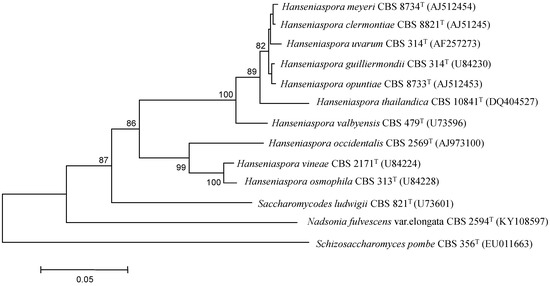
Figure 2.
Phylogenetic relationships between type strains of Hanseniaspora species and other grape or wine-related apiculate yeasts. The dendrogram was constructed using partial 26S rRNA gene sequences by the neighbor-joining method. The robustness of the branching is indicated by bootstrap values (%) calculated for 1000 subsets. The entries of the different genotypes include the accession numbers of the GenBank database sequences. Schizosaccharomyces pombe type strain was used as an outgroup.
2.2. Comparative Analysis of Hanseniaspora Genomes
Today, 10 strains belonging to six different Hanseniaspora species have been completely sequenced [40,41,42,43]. The data collected from these sequences (Table 1) evidence the close relation between H. vineae and H. osmophila that present a similar genome size and G + C percentage compared with the others. Moreover, the protein count is quite similar throughout the species from the genus, but the number of contigs and scaffolds reported vary widely among different species. As informed by karyotyping approaches, H/K species could present between seven and nine chromosomes [29,30]. In a recent study based on field inversion gel electrophoresis and the whole genome sequencing of type strain H. uvarum DSM2768, seven chromosomes were detected [44]. Notwithstanding, there are wide differences in genome size and chromosome number in karyotyping results from natural grape samples. Besides, Hanseniaspora genus belongs to the group of yeast that does not undergo whole-genome duplication, contrary to Saccharomyces [44]. These discrepancies were previously detected in the mitochondrial DNA of H. uvarum. It presented a reduced size compared with those from other yeasts and also a different organization of genes [45].

Table 1.
Hanseniaspora genome assembly statistics.
There are also some differences in the information about genes linked to interesting oenological traits. The highest number of alcohol dehydrogenases, like ADH1, ADH2, ADH3, ADH4, ADH6, and ADH7, from SC is found in the H. vineae genome. It presents eight genes for alcohol dehydrogenases, followed by H. osmophila with six. H. uvarum, H. guilliermondii, and H. opuntiae present just four. The highest number of copies could be related to the fermentation capacity, given the alcohol dehydrogenase activity is involved in the last step of the glycolytic pathway [46]. The fermentation ability is considered a hurdle in NS yeast relative to Saccharomyces strains, and thereby an improvement in fermentation performance is necessary to select a strain for wine inoculation. Limited information is available about the functional analysis of protein activities from Hanseniaspora. A key enzyme associated with the glycolytic pathway is pyruvate kinase. Langenberg et al. [44] recently demonstrated the correlation between pyruvate kinase activity and the enhanced fermentative ability of SC compared with H. uvarum. The authors explained this difference was due to a lowered specific activity rather than the structure of this enzyme. H. vineae and H. osmophila present higher sequence homology (Figure 3) in the predicted protein corresponding to the CDC19 gene from SC than H. uvarum and other H/K species. Further biochemical studies will clarify the potential pyruvate kinase activity in H/K species compared to H. uvarum and SC.
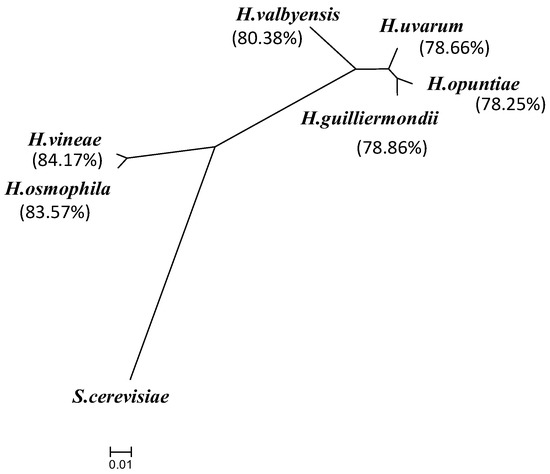
Figure 3.
Relative homology of predicted protein sequences from the CDC19 gene for pyruvate kinase activity in genome-sequenced Hanseniaspora strains (H. vineae T02/19AF; H. osmophila AWRI3579; H. guilliermondii UTAD222; H. opuntiae AWRI3578; H. valbyensis NRRL Y-1626; H. uvarum AWRI3580; Saccharomyces cerevisiae S288c). Data sequences have been collected from the NCBI protein database. Unrooted trees have been constructed using neighbor-joining analysis to calculate the percentage divergence. The percentage of identity with SC is expressed in brackets and calculated as the number of identical amino acids based on the total length.
The lack of nutrients, especially nitrogen, is a leading concern in wine fermentation that can cause stuck or sluggish fermentations [47,48]. Some genes linked to the regulation of nitrogen consumption have been identified in SC [49]. The general amino acid permease activity is attributed to GAP1 in SC, and homologous sequences are present in a high copy number. For instance, 12 GAP1 homologues were detected in the H. guilliermondii UTAD222 genome. Ammonium permeases are also involved in the regulation of nitrogen metabolism; MEP2 homologues were found in all H/K species sequenced, and MEP3 similar sequences were found just in H. uvarum and H. osmophila. The absence of MEP3 in H. vineae might explain the inability of this species to use ammonium salts, as reported for agave juice fermentations [22].
Several enzymes that contribute to wine aroma have been extensively described in SC. One of them, IAH1, codifies for isoamyl acetate hydrolysing esterase, which adds to the production of desired volatile esters. The genomes of H. osmophila, H. opuntiae, H. uvarum, and H. guilliermondii present sequences that codify for a predicted protein highly similar to IAH1. Instead, ATF2 and EHT1 are both alcohol acetyltransferases. The activity of ATF2 is affiliated with the formation of volatile esters during SC fermentation, and EHT1 is linked to short-chain esterase activity [46]. Putative homologous alcohol acetyltransferases were predicted from DNA sequences only present in the genomes of H. osmophila and H. vineae [40].
The increase in sequences from whole genomes of Hanseniaspora strains available in databases is a good starting point to apply the biotechnological potential that these yeasts represent for oenology. Indeed, promising results were obtained in an attempt to genetically modify H. guilliermondii strains [50].
3. Hanseniaspora/Kloeckera Strains and Flavor Compounds
H/K yeasts may affect the wine fermentation directly, by producing flavors, and indirectly, by modulating the growth and metabolism of SC.
More recently, NS wine yeasts have received special attention by winemakers due to the search of different and desired oenological characteristics, compared to SC commercial strains. Diverse secondary metabolic pathways and higher enzymatic activities (esterases, β-glycosidases, lipases, and proteases), result in sensory complexity [1,51,52] that might contribute to an increased diversity of ‘flavor phenotypes’. The ‘flavor phenotype’ is an interesting concept for yeast selection, considering that now more than 1300 volatile compounds can be determined in wine [2,53].
In recent years, the genus H/K has been the subject of considerable study and publications, due to its positive contribution to the sensory characteristics of wines. Specifically, the yeast H. vineae of this genus has been of great interest because it produces several key aromatic compounds and has a good fermentation capacity. A strain of H. vineae isolated from Uruguayan vineyards was selected because of its positive effect on wine fermentation and contribution to the aroma profile of the final wine [18]. H. vineae has been demonstrated to increase fruity aromas and produce a high amount of acetate esters, such as 2-phenylethyl acetate and ethyl acetate (Figure 4), both in laboratory assays and in wines elaborated by sequential fermentation with SC [18,54].
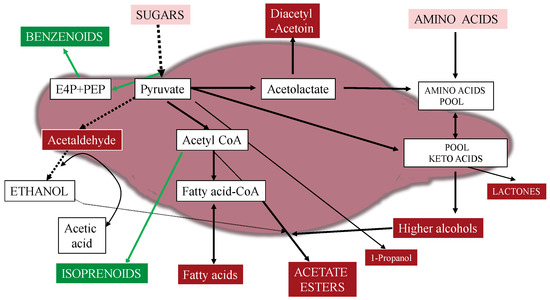
Figure 4.
Fermentation flavor compounds produced by Hanseniaspora/Kloeckera yeasts during wine production (red and green boxes). Specific metabolic pathways that are highlighted in some species of this genus are shown in green (arrows and boxes). Pink boxes are the medium nutrients and doted arrows showed the main glycolysis pathway of primary fermentation.
Various groups of volatile compounds are produced during fermentation with H/K genus. For example, the use of a selected H. uvarum strain in mixed fermentation with commercial SC F5 increased the medium-chain fatty acid ethyl ester content in both synthetic media and grape must of Cabernet Gernischt grapes [55]. However, Medina et al. [18] did not find a significant increase in ethyl ester, using co-fermentation with H. vineae in Chardonnay grape must. In this work, decreases in the higher alcohols content—including 1,3-propanediol, 3-methyl 1-propanol, and tyrosol—were detected. Similar results were revealed in treatments with H. uvarum, finding a lower concentration of higher alcohols than the treatments inoculated with the SC isolates [56]. On the contrary, co-fermentation with H. opuntiae increased the amount of higher alcohols (phenylethanol and 3-methyl-butanol) and phenylacetaldehyde, in Cabernet Sauvignon grape must, intensifying the floral and sweet attributes of wine [57].
All H/K species increase the concentration of almost all the acetate esters. For example, all the acetate esters determined, except isoamyl acetate, were significantly affected by the inclusion of H. osmophila in a starter [58]. In this case, ethyl acetate and β-phenylethyl acetate concentrations in wine were increased when the proportion of H. osmophila in the culture increased. In wines fermented with the H/K:SC culture ratio of 90:10, the concentration of β-phenylethyl acetate was approximately 9-fold greater than that produced by SC pure culture [58]. In cold pre-maceration of Pinot noir grapes, inoculation with H. uvarum had the highest ethyl acetate level among the treatments evaluated, as well as high concentrations of the aforementioned branch-chained esters and, also, isoamyl acetate and isobutyl acetate [56]. In another report, the increased acetate ester levels were increased when H. uvarum was inoculated 48 h before SC, in different wine varieties, demonstrating that their enhancement could be induced by high population proportions of H. uvarum to SC. However, excessive H. uvarum yeasts in the inoculation slowed down the fermentation rate and produced a nail polish-like odour in Cabernet Sauvignon wines, by increasing the contents of acetate esters and volatile phenols [59]. Conversely, the wines produced from Negroamaro grapes by co-fermentation with H. uvarum showed an increment of acetate esters (ethyl acetate, isoamyl acetate and β-phenylethyl acetate) and fatty acids esters (ethyl hexanoate, ethyl octanoate and ethyl decanoate). In particular, an increase of isoamyl alcohol and β-phenyl alcohol was shown when compared to the wines produced by the SC starter [60].
Volatile compounds produced during fermentation of Macabeo grapes inoculated with H. vineae and separately with SC demonstrated significant differences in the acetates and higher alcohols. The H. vineae vinification produced low levels of higher alcohols and 5-fold greater concentration of the acetates [26]. Interesting, in this work, three compounds, 4-ethyl guaiacol, N-acetyltyramine and 1H-indole-3-ethanol acetate ester, were identified in wines with H. vineae but not in the wine fermented with SC [26].
3.1. De Novo Synthesis of Benzenoids and Isoprenoids
Benzyl alcohol, benzaldehyde, p-hydroxybenzaldehyde and p-hydroxybenzyl alcohol, compounds typically synthesised by plants, are synthesised de novo in the absence of grape-derived precursors by H. vineae. Levels of benzyl alcohol produced by 11 different H. vineae strains were 20−200 times higher than those measured in fermentations with SC strains. The absence of PAL in H. vineae suggests that benzenoids are necessarily dependent on de novo synthesis from chorismate [61,62]. It is worth noting that the increased use of diammonium phosphate, mainly applied in winemaking for increasing ester production or avoiding hydrogen sulphide formation, will decrease the production of phenylpropanoid compounds (Figure 5), compromising the final flavor complexity of the wine [61,62].
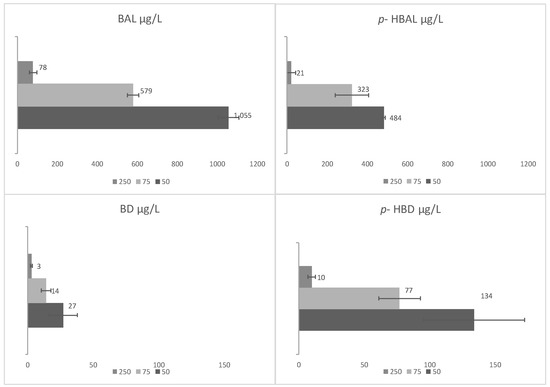
Figure 5.
Formation of benzyl alcohol (BAL), benzaldehyde (BD), p-hydroxybenzyl alcohol (p-HBAL), and p-hydroxybenzaldehyde (p-HBD) by Hanseniaspora vineae 12/196 in the chemically-defined grape medium with three yeast assimilable nitrogen levels, where nitrogen levels of 75 and 250 mg/L were reached via the addition of diammonium phosphate. Fermentations were conducted at 20 °C; data are expressed in micrograms per liter.
Contrariwise, H. vineae produces high concentrations of the benzenoid and phenylpropanoid acetates. In the vinification of Macabeo grape must with H. vineae, 50 times more 2-phenylethyl acetate was generated than in vinifications with SC [26]. A similar trend was seen during de novo synthesis of monoterpenes by H. uvarum, where significant levels of citronellol were detected compared to SC strains. More recently, studies have shown the formation of terpenes and sesquiterpenes in vinifications with different H. vineae strains (Figure 6) exceeded the threshold values and reached higher concentrations than sole fermentation by SC [63].
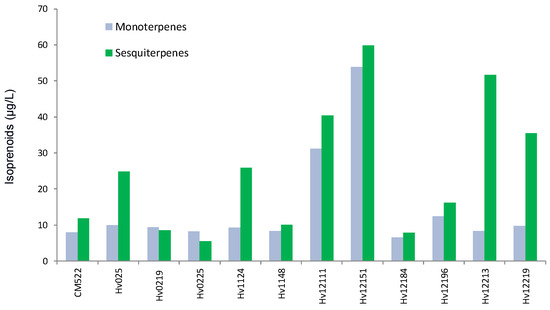
Figure 6.
Production of isoprenoids (monoterpenes and sesquiterpenes) by various strains of Hanseniaspora vineae and the reference Saccharomyces cerevisiae CM522.
3.2. β-Glucosidase
Recently, Hu et al. [59] reported that β-glucosidase activity of H. uvarum yeast was 6.6-fold higher than that of the few naturally found SC strains. This characteristic explained why the participation of H. uvarum yeasts contributed to the increase of free terpene and C13-norisoprenoid contents with sensory impact [59]. However, high levels of β-glucosidase activity also increased the volatile phenol content, which might impart spicy odor traits to wines.
In a previous work, Mendes Ferreira et al. [64] studied the β-glucosidase activity using the p-nitrophenyl-β-d-glycoside (pNPG) as substrate in H. uvarum (formerly K. apiculata), Pichia anomala, and Metschnikowia pulcherrima, detecting the highest activity in H. uvarum. Furthermore, these authors demonstrated that H. uvarum was able to release some monoterpenols from an extract of Muscat grape juice, such as linalool, geraniol and in less quantity 3,7-dimethyl-1,7-octadien-3,6-diol and 3,7-dimethyl-1,5-octadien-3,7-diol, nerol, trans o-cimenol, α-terpineol, and citronellol [64].
The investigation of 31 H/K strains, including H. guilliermondii, H. osmophila, H. uvarum, and H. vineae, showed β-glucosidase and β-xylosidase activities (remarkable in one H. uvarum strain and two H. vineae strains) [65]. However, in this work, Muscat wine (13% v/v, initial alcohol) had only a moderate overall increase in terpene (1.1- to 1.3-fold) when treated with these strains. Specifically, these strains increase the levels of ho-trienol, β-phenylethanol, and 2,6-dimethyl-3,7-octadien-2,6-diol in the wine [65].
3.3. Effect of Hanseniaspora on the Volatile Compounds Produced during Tannat Red Grape Vinification
The vinification of Tannat grapes was conducted at three production scales: semi-pilot (20 kg), pilot (500 kg) and industrial (5000 kg) [66]. Figure 7 depicts the main flavor compound groups produced. The highest formation of acetates was detected in the vinifications with H. vineae, whereas, the maximum ethyl acetate concentration occurred in the vinification with H. clermontiae. Interestingly, the greatest concentration of norisoprenoid compounds was achieved by H. vineae vinification at industrial-scale compared to micro-fermentations.
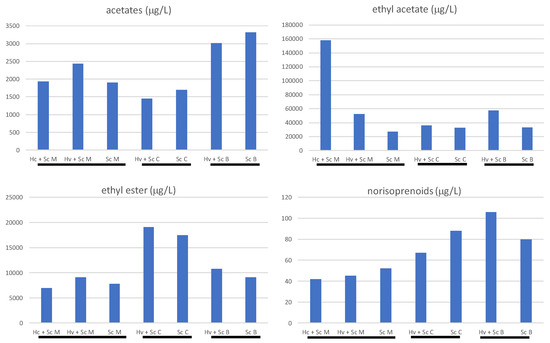
Figure 7.
Concentration of principal groups of volatile compounds in vinifications at semi-pilot (M), pilot (C) and industrial (B) scale. Vinifications were inoculated with Hanseniaspora vineae (Hv), Hanseniaspora clermontiae (Hc) and Saccharomyces cerevisiae (Sc).
4. Hanseniaspora/Kloeckera Strains and Red Wine Color
The yeasts and grape maceration technology utilised during the vinification process affects pigment contents and the final red wine color [67,68,69]. Interactions between yeasts and anthocyanins during fermentation involve a range of mechanisms that might decrease or increase color. Yeast cell wall anthocyanin adsorption [70,71,72] and β-glucosidase activity, which releases the corresponding glycosylated anthocyanidin, exposing it to ready oxidation or conversion to colorless compounds [73], are well-known phenomena. Further research in the last decade has proved that some key compounds released during fermentation, such as pyruvic acid and acetaldehyde, are reactive precursors in the formation of new stable pigments. Vitisin A, vitisin B and ethyl-linked anthocyanin-flavanol pigments are examples of anthocyanin-derived compounds produced by SC strains [72,74,75,76,77,78,79,80]. Yeast strain selection strongly affects color intensity (CI) and the final concentrations of the anthocyanins [81,82] and other phenolic compounds [82].
Recently, studies have proven that some NS species might also be involved in wine color stabilisation [83,84]. As it was expected, some of these reactions could be attributed to the variable levels of acetaldehyde or pyruvate synthesis by different yeast species. For example, Pichia species generated significantly higher levels of acetaldehyde compared with Saccharomyces [85], and acetaldehyde increased linearly with increasing cell biomass concentration [86]. Except for a few reports on Pichia, Schizosaccharomyces and, more recently, some species of Hanseniaspora [83,87,88], limited information has been presented about the effect of NC strains on wine color composition. For the selection of new yeasts for the application with Vitis vinífera L. cv Tannat, a widely grown cultivar in Uruguay and one of the richest varieties in polyphenolic compounds [89,90], a program to select native NS yeasts and thereby increase the yeast diversity for fermentation without affecting wine color, was developed [91]. The Tannat grape juice model medium utilised allowed to screen the strains’ capacity to synthesise anthocyanin-derived compounds while avoiding the interference of grape solids, such as the skin and seeds, was demonstrated previously for SC strains [72].
According to Medina [66], who evaluated 22 native H/K species for their effect on total anthocyanins (TA), CI, hue and total polyphenol index (TPI), the TPI values did not differ significantly between strains. The parameters with the greatest variation were CI with 32% (Figure 8), followed by TA with 30%, and then hue with 24%.
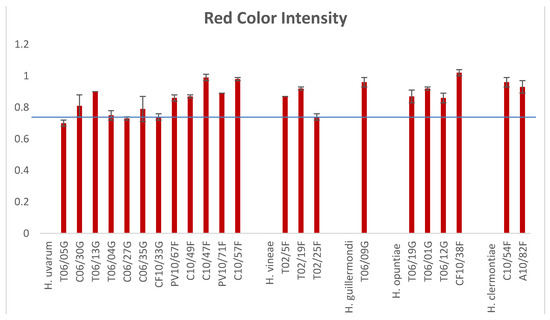
Figure 8.
Mean normalised value and standard deviation of color intensity (sum of absorbance at 420, 520 and 620 nm), for 22 strains of five different Hanseniaspora species. The blue line indicates the average of the four lowest values obtained.
In the same study [26], consideration of the impact of CI and TA as the main color parameters in wines, the following strains were selected: H. guilliermondii (T06/09G), H. opuntiae (T06/01G), H. vineae (T02/5F) and H. clermontiae (A10/82F and C10/54F). Anthocyanin content and CI were evaluated against the best SC (882), previously selected for red grape fermentations [72]. All the previous selected H/K strains formed vitisin B, vitisin A, malvidin-3-O-glucoside-4-vinylphenol, malvidin-3-O-glucoside-4-vinylguaiacol (Figure 9, shows with letters A, B, C and D respectively).
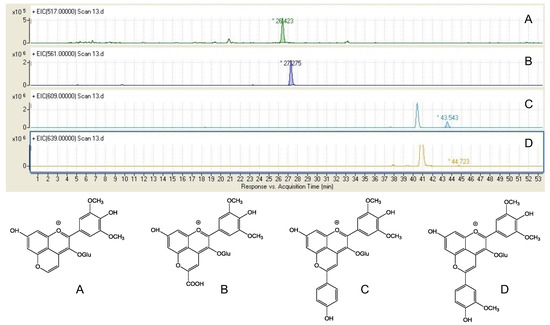
Figure 9.
Identification of anthocyanin-derived pigments of Tannat grapes during fermentation by Hanseniaspora/Kloeckera yeasts that contribute to enhanced color stability.
Vitisin B formation has been reported previously only for SC yeasts [77,78,81,92]. Results of the anthocyanin-derived compounds formed during fermentation in the mentioned model grape medium indicated vitisin B could be linked to the increased acetaldehyde levels produced by SC when compared with NS yeasts [93]. All the NS strains selected showed vitisin B formation, despite some relatively low concentrations recorded relative to that formed by Saccharomyces yeast. For vitisin A, in contrast, there was a greater formation with NS strains than SC, possibly linked to the presence of pyruvic acid in the medium [78]. In corroboration with these findings, Morata et al. [83] noticed that in comparison to SC, Schizosaccharomyces pombe produced more pyruvic acid. Differences in the levels of pyruvic acid production might be explained by the particular “Crabtree effect” of each yeast species [94], which is defined as a system where respiration is repressed under high concentration of sugars. SC strains display a positive Crabtree effect and, consequently, this species presents a greater ethanol fermentation efficacy than many negative-Crabtree effect NS strains [94]. According to the literature, the production of vitisin A has been reported for SC [71,77,78], Schizosaccharomyces pombe [83,88] and, more recently, for some species of the H/K genus (H. guilliermondii, H. opuntiae, H. vineae, and H. clermontiae) [91,93].
Conversely, another anthocyanin-derived compound (malvidin-3-O-glucoside-4-vinylguaiacol) was detected during alcoholic fermentation with SC 882 [72], other SC strains [79,80,81,95] and Pichia guilliermondii [87]. The first report on the formation of this derived compound for the yeast genera Hanseniaspora and Metschnikowia was relatively more recent [91]. In that work, the authors argued that the high concentration of malvidin-3-glucoside-4-vinylguaicol found for all yeast treatments might also be a consequence of the differences in the grape variety and the concentrations of the respective hydroxycinnamic acids [96,97].
Formation of pigments derived from vinylphenol and vinylguaiacol could be explained by the hydroxycinnamate decarboxylase (HCDC) activity. The HCDC activity, specifically for supplying coumaric acid, has been mentioned for strains of the genera Pichia, Torulaspora, and Zygosaccharomyces [98,99]. A high HCDC activity of 90% for P. guilliermondii was recently noticed, which significantly influenced the formation of vinyl phenolic pyranoanthocyanins [87]. The work confirmed that during mixed or sequential fermentations carried out with NS or highly fermentative SC strains, with high HCDC activity, the content of stable pigments could be increased [87].
5. Applications of Hanseniaspora/Kloeckera Strains in Winemaking
Mixed-culture fermentation with Saccharomyces wine yeast is a controlled manner to apply NS strains, where the positive effects of NS yeasts and a complete dry fermentation is obtained. Even though SC produces most of the ethanol in wine, the NS yeasts present in the grape must, play a significant role in producing aroma compounds [16,100], contributing to diverse ‘flavor phenotypes’.
As mentioned above, it is currently widely accepted that the secondary metabolites formed by properly selected NS yeasts, some of them already commercially available, during alcoholic fermentation positively affect the quality of wines [1,3,100,101,102,103]. The great variety of such yeasts allows designing different selected starter cultures (in conjunction with SC). Enhanced varietal and fermentative aromas, glycerol production, or specific enzymatic activities might be obtained, based on the ability of these yeasts to ferment different wine varieties [3]. As a result, winemakers can adapt wines to consumers searching for flavor diversity [37].
Yeasts of the genus H/K are frequently isolated during the first stages of the fermentation and are also found on the surface of the grapes, as well as in the soil, cellar, harvesting machinery, and during the processing of these fruit [104,105]. Based on current knowledge, H/K is one of the NS yeast genera with a major contribution to the sensory quality of wines. The H/K tend to be the dominant yeasts in the early stages of fermentation [26,37,106,107,108], perhaps attributed to their high population found in grapes or high tolerance to osmotic pressure (>200 g/L).
As the fermentation process progresses, the presence of H/K decreases, as a result of their low capacity to adapt to increasing levels of ethanol [109,110], although H. uvarum could be found until the end of fermentation, in some situations [55]. With the aid of culture-independent molecular techniques, it was possible to verify that some H. vineae strains are maintained until the end of fermentation, but their proportion decreases compared to SC [26]. This behavior can be seen in Figure 10, where the presence of H. vineae and other Hanseniaspora yeast is observed until the end of fermentation, at the semi-industrial scale of Merlot and Macabeo grapes [26].
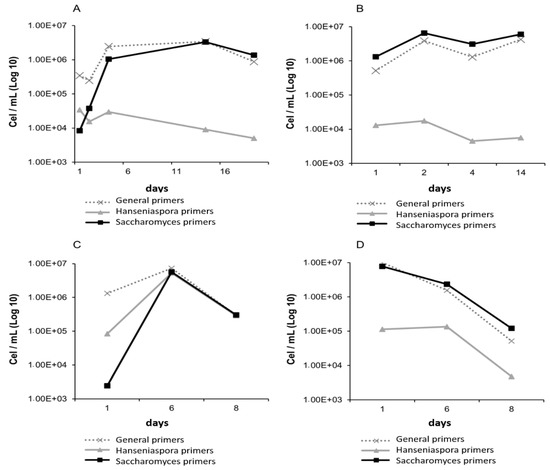
Figure 10.
Monitoring of the yeast population by quantitative polymerase chain reaction, with general primers for yeasts (punctate), specific for Hanseniaspora spp. (grey) and specific for Saccharomyces (black), in Macabeo (A,B) and Merlot fermentations (C,D), in tanks inoculated with H. vineae (A,C) and tanks inoculated with S. cerevisiae (B,D).
In general, H/K shows a medium/low fermentative capacity (reaching up to 9% ethanol in some cases) [107]. Although the behavior of Hanseniaspora yeasts stands out from other NS yeasts [91,93] and, under certain conditions, give a better or no differences in performance against a Saccharomyces control [59,63], this is not a genus-dependent behavior but rather a strain-dependent characteristic. However, as seen in Figure 11, H. vineae is one of the main H/K fermenters, a character that corroborates the already-mentioned high homology of the pyruvate kinase gene with SC compared to the other H/K species (Figure 2). This result also justifies why is so difficult to isolate “vineae” species from grapes, yet readily detect them after two days of fermentation [63]. Likewise, the fermentation efficacy can be influenced by the inoculation procedures for mixed cultures. If the inoculation occurs sequentially, then the fermentation will be slowed down compared to simultaneous inoculations, due to cell retention of nutrients, and an additional nutrient addition will be necessary when the second inoculation is done [17]. Although SC has a higher capacity for fermentation than H/K strains, the lack of nutrients after 48 h will cause a sluggish fermentation process [8,59,93,111]. This tendency was also shown with different H. clermontiae strains [91,93]. The fermentative capacity and cell survival under mixed fermentation conditions can also be affected by the size of the inoculum. Good performances were obtained when H. uvarum was inoculated simultaneously and at twice the proportion of SC [60].
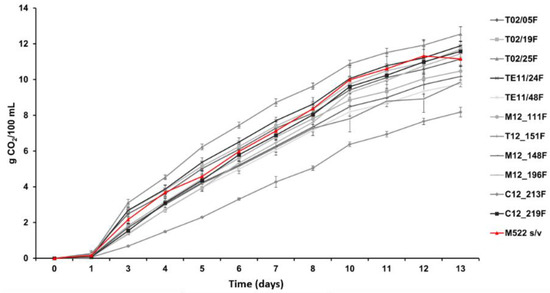
Figure 11.
Fermentation kinetics of 11 strains of Hanseniaspora vineae at 20 °C, with a daily agitation. The yeast M522 (Saccharomyces cerevisiae) was used as a control (red). Data for CO2 were obtained with cotton plug flask fermenters that include an average loss of 3 g of water vapor for every treatment.
H/K strains are considered important during vinification since they produce aromatic compounds of interest and modify the chemical composition of wines [9,10,11,18,112]. Two species stand out for producing high amounts of β-phenylethyl acetate, H. guilliermondii [113], and H. vineae [18,26,54,58,61,62,114]. However, this compound is not found at such high levels in the other species, as discussed above. This ester is associated with fruity, floral (rose) and honey sensory notes [100,115,116,117]. H. uvarum and H. guilliermondii have been reported as producing high levels of sulphur-containing aromatics [112]. At the same time, co-fermented wines with H/K strains presented more body and greater aromatic complexity in the mouth compared to SC solo fermentations [26], positively contributing to the final wine (Figure 12). Wines obtained at the semi-industrial scale from inoculums with H. vineae and then finished spontaneously with SC were preferred by a sensory panel than wines inoculated with a commercial SC, as a result of a higher floral descriptor, increased volume, increased structure and, ultimately, a better overall concept of the wine obtained. For body and mouth volume, no significant increase of glycerol or polysaccharides were recorded for H. vineae strains [63]. However, increased cell lysis was evident compared to SC commercial strains. Furthermore, the increase presence of C10 compounds found in wines fermented with H. vineae, suggest the existence of a faster autolysis rate compared to SC, as this flavor parameter was related to cell lysis by some authors for other yeast species [118,119]. The cell walls of H. valbyensis strains are reportedly about five times more sensitive to hydrolysis than those of SC, which is why they were used for a yeast glucan enzymatic tests [120]. Interestingly, Chardonnay barrel-fermented wines with mixed cultures of H. vineae/SC had significantly decreased biogenic amines and volatile acidity and increased glycerol and dry weight levels compared to pure SC fermentations [18]. The dry weight increase might also be associated with an increased cell lysis behavior of H. vineae. The authors of that study also showed cooperation between mixed cultures of H. vineae/SC with malolactic bacteria fermentation, by a significant stimulation compared to SC pure fermentation, finishing the process earlier by 45 days. More recently, these data were confirmed in red wine fermentations, also at an industrial scale [63], but further studies are needed to understand how the lactic bacteria were stimulated by this yeast.
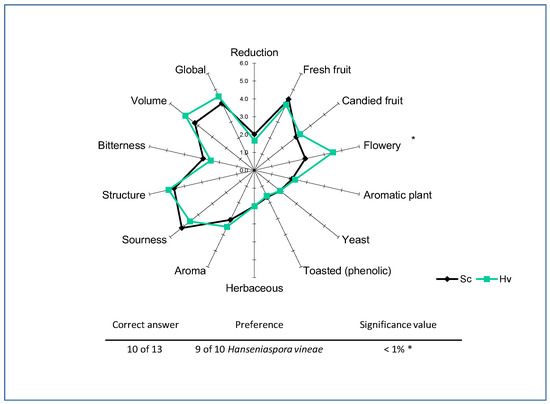
Figure 12.
Results of the triangle (table) and descriptive (graphic) test of Macabeo wine fermented with Hanseniaspora vineae and Saccharomyces cerevisiae. Significant value * is indicated for flowery.
Most of these positive contributions by H/K yeasts can be explained by the presence of increased enzymatic activity compared to SC. The presence of active enzymes depends, in part, on the carbon and nitrogen sources present in the grape must. Small changes in the concentration of these nutrients can affect the nature, quantity, and diversity of the secreted enzymes [121]. The enzymes most commonly studied for their role during vinification are proteases, β-glucosidases, and pectinases since they intervene in sensory attributes, such as the color, aromas, and stability of wines [122]. Most NS yeasts have some enzymatic activity [123]. Hanseniaspora spp. are considered to be one of the primary producers of glycolytic and protease activities [63,105,124]. It was recently reported that within the NS yeast that contribute to the organoleptic quality of wines, H. uvarum had the highest enzymatic activity [1,3].
6. Conclusions
An insight into apiculate yeast biology showed that H/K is the principal genus found in mature grapes and these yeasts have interesting potential applications for wine fermentation. It is evident that selected strains of H/K yeasts might beneficially enhance the aroma and flavor attributes of wines and, more recently, this was proved for some H/K species. At the real winemaking scale, mixed cultures of H. guilliermondii/SC, H. uvarum/SC, and H. vineae/SC increase flavor diversity and thereby complexity. White and red grape varieties—such as Bobal, Macabeo, Chardonnay, Pinot Noir, Negroamaro, Tempranillo, Cabernet Sauvignon, Merlot, and Tannat—resulted in wines with improved sensorial profile.
Concurrently, it was confirmed that various Hanseniaspora species (H. clermontiae, H. opuntiae, H. guilliermondii, and H. vineae) contribute to the polyphenolic composition and color of the red wines. Thus, it was possible to demonstrate for the first time that the increased anthocyanin derived compounds generated from the mixed culture fermentation of these yeasts, enhanced the red wine color perception.
This set of mentioned characteristics (fermentative capacity, enzymatic activity, production of aromatic compounds, and ability to enhance the color of wines) makes the genus H/K a suitable stock for the selection of unconventional yeasts in commercial winemaking. Although H/K strains are still not easily available for their application, winemakers will have the opportunity to differentiate and increase regional characteristics to highlight their wines in a hugely competitive market.
Author Contributions
V.M., M.J.V., K.M., E.B. and F.C. contribute to the conception and search of data for this review, M.J.V., E.B. and F.C. analyze original data, M.J.V. and F.C. wrote the paper.
Funding
This research was funded by Agencia Nacional de Investigacion e Innovacion ANII of Uruguay.
Acknowledgments
We wish to thank ANII Postgraduate POS_NAC_2012_1_9099, Agencia Nacional de Investigación e Innovación (ANII) and to the postgraduate academic commission for the postgraduate completion scholarship granted to VM. We are also grateful for the financial support of ANII Project FMV_1_2011_1_6956, and the postdoctoral fellowships of MJV, ANII PD_NAC_2016_1_133945 and Clarín-COFUND from Principado de Asturias and European Union.
Conflicts of Interest
The authors declare no conflict of interest.
References
- Jolly, N.P.; Varela, C.; Pretorius, I.S. Not your ordinary yeast: Non-Saccharomyces yeasts in wine production uncovered. FEMS Yeast Res. 2014, 14, 215–237. [Google Scholar] [CrossRef] [PubMed]
- Carrau, F.; Gaggero, C.; Aguilar, P.S. Yeast diversity and native vigor for flavor phenotypes. Trends Biotechnol. 2015, 33, 148–154. [Google Scholar] [CrossRef] [PubMed]
- Padilla, B.; Gil, J.V.; Manzanares, P. Past and Future of Non-Saccharomyces Yeasts: From Spoilage Microorganisms to Biotechnological Tools for Improving Wine Aroma Complexity. Front. Microbiol. 2016, 7, 411. [Google Scholar] [CrossRef] [PubMed]
- Rosini, G.; Federici, F.; Martini, A. Yeast flora of grape berries during ripening. Microb. Ecol. 1982, 8, 83–89. [Google Scholar] [CrossRef] [PubMed]
- Loureiro, V.; Ferreira, M.M.; Monteiro, S.; Ferreira, R.B. The Microbial Community of Grape Berry. In The Biochemistry of the Grape Berry; Gerós, H., Chaves, M., Delrot, S., Eds.; Bentham Science Publishers: Soest, The Netherlands, 2012; pp. 241–268. [Google Scholar]
- Renouf, V.; Claisse, O.; Lonvaud-Funel, A. Inventory and monitoring of wine microbial consortia. Appl. Microbiol. Biotechnol. 2007, 75, 149–164. [Google Scholar] [CrossRef] [PubMed]
- Varela, C.; Borneman, A.R. Yeasts found in vineyards and wineries. Yeast 2017, 34, 111–128. [Google Scholar] [CrossRef] [PubMed]
- Di Maro, E.; Ercolini, D.; Coppola, S. Yeast dynamics during spontaneous wine fermentation of the Catalanesca grape. Int. J. Food Microbiol. 2007, 117, 201–210. [Google Scholar] [CrossRef] [PubMed]
- Herraiz, T.; Reglero, G.; Herraiz, M.; Martin-Alvarez, P.J.; Cabezudo, M.D. The influence of the yeast and type of culture on the volatile composition of wines fermented without sulfur dioxide. Am. J. Enol. Vitic. 1990, 41, 313–318. [Google Scholar]
- Mateo, J.; Jimenez, M.; Huerta, T.; Pastor, A. Contribution of different yeasts isolated from musts of Monastrell grapes to the aroma of wine. Int. J. Food Microbiol. 1991, 14, 153–160. [Google Scholar] [CrossRef]
- Zironi, R.; Romano, P.; Suzzi, G.; Battistutta, F.; Comi, G. Volatile metabolites produced in wine by mixed and sequential cultures of Hanseniaspora guilliermondii or Kloeckera apiculata and Saccharomyces cerevisiae. Biotechnol. Lett. 1993, 15, 235–238. [Google Scholar] [CrossRef]
- Gil, J.; Mateo, J.; Jimenez, M.; Pastor, A.; Huerta, T. Aroma compounds in wine as influenced by apiculate yeasts. J. Food Sci. 1996, 61, 1247–1266. [Google Scholar] [CrossRef]
- Caridi, A.; Crucitti, P.; Ramondino, D. Winemaking of musts at high osmotic strength by thermotolerant yeasts. Biotechnol. Lett. 1999, 21, 617–620. [Google Scholar] [CrossRef]
- Romano, P.; Suzzi, G.; Comi, G.; Zironi, R. Higher alcohol and acetic acid production by apiculate wine yeasts. J. Appl. Bacteriol. 1992, 73, 126–130. [Google Scholar] [CrossRef]
- Ciani, M.; Maccarelli, F. Oenological properties of non-Saccharomyces yeasts associated with wine-making. World J. Microbiol. Biotechnol. 1998, 14, 199–203. [Google Scholar] [CrossRef]
- Romano, P.; Suzzi, G.; Domizio, P.; Fatichenti, F. Secondary products formation as a tool for discriminating non-Saccharomyces wine strains. Antonie van Leeuwenhoek Int. J. Gen. Mol. Microbiol. 1997, 71, 239–242. [Google Scholar] [CrossRef]
- Medina, K.; Boido, E.; Dellacassa, E.; Carrau, F. Growth of non-Saccharomyces yeasts affects nutrient availability for Saccharomyces cerevisiae during wine fermentation. Int. J. Food Microbiol. 2012, 157, 245–250. [Google Scholar] [CrossRef] [PubMed]
- Medina, K.; Boido, E.; Fariña, L.; Gioia, O.; Gomez, M.E.; Barquet, M.; Gaggero, C.; Dellacassa, E.; Carrau, F. Increased flavour diversity of Chardonnay wines by spontaneous fermentation and co-fermentation with Hanseniaspora vineae. Food Chem. 2013, 141, 2513–2521. [Google Scholar] [CrossRef] [PubMed]
- Arneborg, N.; Siegumfeldt, H.; Andersen, G.H.; Nissen, P.; Daria, V.R.; Rodrigo, P.J.; Glückstad, J. Interactive optical trapping shows that confinement is a determinant of growth in a mixed yeast culture. FEMS Microbiol. Lett. 2005, 245, 155–159. [Google Scholar] [CrossRef] [PubMed]
- Bataillon, M.; Rico, A.; Salmon, J.-M.; Barre, P. Early Thiamin Assimilation by Yeasts under Enological Conditions: Impact on Alcoholic Fermentation Kinetics. J. Ferment. Bioeng. 1996, 82, 145–150. [Google Scholar] [CrossRef]
- Wang, X.D.; Bohlscheid, J.C.; Edwards, C.G. Fermentative activity and production of volatile compounds by Saccharomyces grown in synthetic grape juice media deficient in assimilable nitrogen and/or pantothenic acid. J. Appl. Microbiol. 2003, 94, 349–359. [Google Scholar] [CrossRef] [PubMed]
- Díaz-Montaño, D.M.; Favela-Torres, E.; Córdova, J. Improvement of growth, fermentative efficiency and ethanol tolerance of Kloeckera africana during the fermentation of agave tequilana juice by addition of yeast extract. J. Sci. Food Agric. 2010, 90, 321–328. [Google Scholar] [CrossRef] [PubMed]
- Jolly, N.P.; Augustyn, O.P.H.; Pretorius, I.S. The Effect of Non-Saccharomyces Yeasts on Fermentation and Wine Quality. S. Afr. J. Enol. Vitic. 2003, 24, 55–62. [Google Scholar] [CrossRef]
- Rojas, V.; Gil, J.V.; Piaga, F.; Manzanares, P. Studies on acetate ester production by non-Saccharomyces wine yeasts. Int. J. Food Microbiol. 2001, 70, 283–289. [Google Scholar] [CrossRef]
- Moreira, N.; Pina, C.; Mendes, F.; Couto, J.A.; Hogg, T.; Vasconcelos, I. Volatile compounds contribution of Hanseniaspora guilliermondii and Hanseniaspora uvarum during red wine vinifications. Food Control 2011, 22, 662–667. [Google Scholar] [CrossRef]
- Lleixa, J.; Martin, V.; Portillo, C.; Carrau, F.; Beltran, G.; Mas, A. Comparison of the performances of Hanseniaspora vineae and Saccharomyces cerevisiae during winemaking. Front. Microbiol. 2016, 7, 338. [Google Scholar] [CrossRef] [PubMed]
- McLaughlin, R.; Wilson, C.; Droby, S.; Ben, R.; Chalutz, E. Biological control of postharvest diseases of grape, peach an apple with the yeast Kloeckera apiculata and Candida guilliermondii. Plant Dis. 1992, 76, 470–473. [Google Scholar] [CrossRef]
- Rabosto, X.; Carrau, M.; Paz, A.; Boido, E.; Dellacassa, E.; Carrau, F.M. Grapes and vineyard soils as sources of microorganisms for biological control of Botrytis cinerea. Am. J. Enol. Vitic. 2006, 57, 332–338. [Google Scholar]
- Esteve-Zarzoso, B.; Peris-Toran, M.J.; Ramón, D.; Querol, A. Navigating wall-sized displays with the gaze: A proposal for cultural heritage. CEUR Workshop Proc. 2001, 80, 85–92. [Google Scholar]
- Cadez, N.; Raspor, P.; de Cock, A.W.; Boekhout, T.; Smith, M.T. Molecular identification and genetic diversity within species of the genera Hanseniaspora and Kloeckera. FEMS Yeast Res. 2002, 1, 279–289. [Google Scholar] [PubMed]
- Mills, D.A.; Johannsen, E.A.; Cocolin, L. Yeast diversity and persistence in botrytis-affected wine fermentations. Appl. Environ. Microbiol. 2002, 68, 4884–4893. [Google Scholar] [CrossRef] [PubMed]
- Andorrà, I.; Landi, S.; Mas, A.; Esteve-Zarzoso, B.; Guillamón, J.M. Effect of fermentation temperature on microbial population evolution using culture-independent and dependent techniques. Food Res. Int. 2010, 43, 773–779. [Google Scholar] [CrossRef]
- Wang, C.; García-Fernández, D.; Mas, A.; Esteve-Zarzoso, B. Fungal diversity in grape must and wine fermentation assessed by massive sequencing, quantitative PCR and DGGE. Front. Microbiol. 2015, 6, 1156. [Google Scholar] [CrossRef] [PubMed]
- Bokulich, N.A.; Ohta, M.; Richardson, P.M.; Mills, D.A. Monitoring Seasonal Changes in Winery-Resident Microbiota. PLoS ONE 2013, 8, 66437. [Google Scholar] [CrossRef] [PubMed]
- Pinto, C.; Pinho, D.; Cardoso, R.; Custodio, V.; Fernandes, J.; Sousa, S.; Pinheiro, M.; Egas, C.; Gomes, A.C. Wine fermentation microbiome: A landscape from different Portuguese wine appellations. Front. Microbiol. 2015, 6, 905. [Google Scholar] [CrossRef] [PubMed]
- Sabate, J.; Cano, J.; Esteve-Zarzoso, B.; Guillamón, J.M. Isolation and identification of yeasts associated with vineyard and winery by RFLP analysis of ribosomal genes and mitochondrial DNA. Microbiol. Res. 2002, 157, 267–274. [Google Scholar] [CrossRef] [PubMed]
- Pretorius, I.S. Tailoring wine yeast for the new millennium: Novel approaches to the ancient art of winemaking. Yeast 2000, 16, 675–729. [Google Scholar] [CrossRef]
- Yamada, Y.; Maeda, K.; Nagahama, T.; Banno, I. The phylogenetic relationships of the Q6-equiped species in the teleomorphic apiculate yeast genera Hanseniaspora, Nadsonia, and Saccharomycoydes based on the partial sequences of 18S and 26S ribosomal ribonucleiic acids. J. Gen. Appl. Microbiol. 1992, 38, 585–596. [Google Scholar] [CrossRef]
- Lleixà, J.; Manzano, M.; Mas, A.; del C. Portillo, M. Saccharomyces and non-Saccharomyces competition during microvinification under different sugar and nitrogen conditions. Front. Microbiol. 2016, 7, 1959. [Google Scholar] [CrossRef]
- Giorello, F.M.; Berná, L.; Greif, G.; Camesasca, L.; Salzman, V.; Medina, K.; Robello, C.; Gaggero, C.; Aguilar, P.S.; Carrau, F. Genome sequence of the native apiculate wine yeast Hanseniaspora vineae T02/19AF. Genome Announc. 2014, 2, e00530-14. [Google Scholar] [CrossRef] [PubMed]
- Riley, R.; Haridas, S.; Wolfe, K.H.; Lopes, M.R.; Hittinger, C.T.; Göker, M.; Salamov, A.A.; Wisecaver, J.H.; Long, T.M.; Calvey, C.H.; et al. Comparative genomics of biotechnologically important yeasts. Proc. Natl. Acad. Sci. USA 2016, 113, 9882–9887. [Google Scholar] [CrossRef] [PubMed]
- Sternes, P.R.; Lee, D.; Kutyna, D.R.; Borneman, A.R. Genome Sequences of Three Species of Hanseniaspora Isolated from Spontaneous Wine Fermentations: TABLE 1. Genome Announc. 2016, 4, e01287-16. [Google Scholar] [CrossRef] [PubMed]
- Seixas, I.; Barbosa, C.; Salazar, S.B.; Mendes-Faia, A.; Wang, Y.; Güldener, U.; Mendes-Ferreira, A.; Mira, N.P. Genome Sequence of the Nonconventional Wine Yeast Hanseniaspora guilliermondii UTAD222. Genome Announc. 2017, 5, e01515-16. [Google Scholar] [CrossRef] [PubMed]
- Langenberg, A.; Bink, F.J.; Wolff, L.; Walter, S.; Grossmann, M.; Schmitz, H. Glycolytic Functions Are Conserved in the Genome of the Wine Yeast Hanseniaspora uvarum, and Pyruvate Kinase Limits Its Capacity for Alcoholic Fermentation. Appl. Environ. Microbiol. 2017, 83, e01580-17. [Google Scholar] [CrossRef] [PubMed]
- Pramateftaki, P.V.; Kouvelis, V.N.; Lanaridis, P.; Typas, M. The mitochondrial genome of the wine yeast Hanseniaspora uvarum: A unique genome organization among yeast/fungal counterparts. FEMS Yeast Res. 2006, 6, 77–90. [Google Scholar] [CrossRef] [PubMed]
- Molina, A.M.; Swiegers, J.H.; Varela, C.; Pretorius, I.S.; Agosin, E. Influence of wine fermentation temperature on the synthesis of yeast-derived volatile aroma compounds. Appl. Microbiol. Biotechnol. 2007, 77, 675–687. [Google Scholar] [CrossRef] [PubMed]
- Bisson, L.F. Stuck and sluggish fermentations. Am. J. Enol. Vitic. 1999, 50, 107–119. [Google Scholar]
- Taillandier, P.; Ramon Portugal, F.; Fuster, A.; Strehaiano, P. Effect of ammonium concentration on alcoholic fermentation kinetics by wine yeasts for high sugar content. Food Microbiol. 2007, 24, 95–100. [Google Scholar] [CrossRef] [PubMed]
- Beltran, G.; Novo, M.; Rozès, N.; Mas, A.; Guillamón, J.M. Nitrogen catabolite repression in Saccharomyces cerevisiae during wine fermentations. FEMS Yeast Res. 2004, 4, 625–632. [Google Scholar] [CrossRef] [PubMed]
- Nguong, D.L.S.; Jun, L.Y.; Yatim, N.I.; Nathan, S.; Murad, A.M.A.; Mahadi, N.M.; Bakar, F.D.A. Characterising yeast isolates from Malaysia towards the development of alternative heterologous protein expression systems. Sains Malays 2011, 40, 323–329. [Google Scholar]
- Andorrà, I.; Berradre, M.; Mas, A.; Esteve-Zarzoso, B.; Guillamón, J.M. Effect of mixed culture fermentations on yeast populations and aroma profile. LWT-Food Sci. Technol. 2012, 49, 8–13. [Google Scholar] [CrossRef]
- Tempère, S.; Marchal, A.; Barbe, J.C.; Bely, M.; Masneuf-Pomarede, I.; Marullo, P.; Albertin, W. The complexity of wine: Clarifying the role of microorganisms. Appl. Microbiol. Biotechnol. 2018, 102, 3995–4007. [Google Scholar] [CrossRef] [PubMed]
- Cordente, A.G.; Curtin, C.D.; Varela, C.; Pretorius, I.S. Flavour-active wine yeasts. Appl. Microbiol. Biotechnol. 2012, 96, 601–618. [Google Scholar] [CrossRef] [PubMed]
- Viana, F.; Belloch, C.; Vallés, S.; Manzanares, P. Monitoring a mixed starter of Hanseniaspora vineae-Saccharomyces cerevisiae in natural must: Impact on 2-phenylethyl acetate production. Int. J. Food Microbiol. 2011, 151, 235–240. [Google Scholar] [CrossRef] [PubMed]
- Hu, K.; Jin, G.-J.; Mei, W.-C.; Li, T.; Tao, Y.-S. Increase of medium-chain fatty acid ethyl ester content in mixed H. uvarum/S. cerevisiae fermentation leads to wine fruity aroma enhancement. Food Chem. 2018, 239, 495–501. [Google Scholar] [CrossRef] [PubMed]
- Hall, H.; Zhou, Q.; Qian, M.C.; Osborne, J.P. Impact of yeasts present during prefermentation cold maceration of pinot noir grapes on wine volatile aromas. Am. J. Enol. Vitic. 2017, 68, 81–90. [Google Scholar] [CrossRef]
- Luan, Y.; Zhang, B.-Q.; Duan, C.-Q.; Yan, G.-L. Effects of different pre-fermentation cold maceration time on aroma compounds of Saccharomyces cerevisiae co-fermentation with Hanseniaspora opuntiae or Pichia kudriavzevii. LWT-Food Sci. Technol. 2018, 92, 177–186. [Google Scholar] [CrossRef]
- Viana, F.; Gil, J.V.; Vallés, S.; Manzanares, P. Increasing the levels of 2-phenylethyl acetate in wine through the use of a mixed culture of Hanseniaspora osmophila and Saccharomyces cerevisiae. Int. J. Food Microbiol. 2009, 135, 68–74. [Google Scholar] [CrossRef] [PubMed]
- Hu, K.; Jin, G.-J.; Xu, Y.-H.; Tao, Y.-S. Wine aroma response to different participation of selected Hanseniaspora uvarum in mixed fermentation with Saccharomyces cerevisiae. Food Res. Int. 2018, 108, 119–127. [Google Scholar] [CrossRef] [PubMed]
- Tristezza, M.; Tufariello, M.; Capozzi, V.; Spano, G.; Mita, G.; Grieco, F. The oenological potential of Hanseniaspora uvarum in simultaneous and sequential co-fermentation with Saccharomyces cerevisiae for industrial wine production. Front. Microbiol. 2016, 7, 1–14. [Google Scholar] [CrossRef] [PubMed]
- Martin, V.; Giorello, F.; Fariña, L.; Minteguiaga, M.; Salzman, V.; Boido, E.; Aguilar, P.S.; Gaggero, C.; Dellacassa, E.; Mas, A.; et al. De novo synthesis of benzenoid compounds by the yeast Hanseniaspora vineae increases the flavor diversity of wines. J. Agric. Food Chem. 2016, 64, 4574–4583. [Google Scholar] [CrossRef] [PubMed]
- Martin, V.; Boido, E.; Giorello, F.; Mas, A.; Dellacassa, E.; Carrau, F. Effect of yeast assimilable nitrogen on the synthesis of phenolic aroma compounds by Hanseniaspora vineae strains. Yeast 2016, 33, 323–328. [Google Scholar] [CrossRef] [PubMed]
- Martín, V. Hanseniaspora vineae: Caracterizacióon y su uso en la Vinificación. Ph.D. Thesis, Universidad de la Republica, Montevideo, Uruguay, 2016. [Google Scholar]
- Mendes Ferreira, A.; Climaco, M.C.; Mendes Faia, A. The role of non-Saccharomyces species in releasing glycosidic bound fraction of grape aroma components—A preliminary study. J. Appl. Microbiol. 2001, 91, 67–71. [Google Scholar] [CrossRef] [PubMed]
- López, S.; Mateo, J.J.; Maicas, S. Characterisation of Hanseniaspora isolates with potential aromaenhancing properties in muscat wines. S. Afr. J. Enol. Vitic. 2014, 35, 292–303. [Google Scholar]
- Medina, K. Biodiversidad de Levaduras no-Saccharomyces: Efecto del Metabolismo Secundario en el Color y el Aroma de Vinos de Calidad. Ph.D. Thesis, Universidad de la Republica, Montevideo, Uruguay, 2014. [Google Scholar]
- Boulton, R. The copigmentation of anthocyanins and its role in the color of red wine: A critical review. Am. J. Enol. Vitic. 2001, 52, 67–87. [Google Scholar]
- Vivar-Quintana, A.M.; Santos-Buelga, C.; Rivas-Gonzalo, J.C. Anthocyanin-derived pigments and colour of red wines. Anal. Chim. Acta 2002, 458, 147–155. [Google Scholar] [CrossRef]
- Schwarz, M.; Wabnitz, T.C.; Winterhalter, P. Pathway leading to the formation of anthocyanin-vinylphenol adducts and related pigments in red wines. J. Agric. Food Chem. 2003, 51, 3682–3687. [Google Scholar] [CrossRef] [PubMed]
- Vasserot, Y.; Caillet, S.; Maujean, A. Study of anthocyanin adsorption by yeast lees. Effect of some physicochemical parameters. Am. J. Enol. Vitic. 1997, 48, 433–437. [Google Scholar]
- Morata, A.; Gómez-Cordovés, M.C.; Suberviola, J.; Bartolomé, B.; Colomo, B.; Suárez, J.A. Adsorption of anthocyanins by yeast cell walls during the fermentation of red wines. J. Agric. Food Chem. 2003, 51, 4084–4088. [Google Scholar] [CrossRef] [PubMed]
- Medina, K.; Boido, E.; Dellacassa, E.; Carrau, F. Yeast interactions with anthocyanins during red wine fermentation. Am. J. Enol. Vitic. 2005, 56, 104–109. [Google Scholar]
- Manzanares, P.; Rojas, V.; Genovés, S.; Vallés, S. A preliminary search for anthocyanin-β-d-glucosidase activity in non-Saccharomyces wine yeasts. Int. J. Food Sci. Technol. 2000, 35, 95–103. [Google Scholar] [CrossRef]
- Asenstorfer, R.E.; Markides, A.J.; Iland, P.G.; Jones, G.P. Formation of vitisin A during red wine fermentation and maturation. Aust. J. Grape Wine Res. 2003, 9, 40–46. [Google Scholar] [CrossRef]
- Eglinton, J.; Griesser, M.; Henschke, P.; Kwiatkowski, M.; Parker, M.; Herderich, M. Yeast-Mediated Formation of Pigmented Polymers in Red Wine. In Red Wine Color; ACS Symposium Series: Washington, DC, USA, 2004. [Google Scholar]
- Lee, D.F.; Swinny, E.E.; Jones, G.P. NMR identification of ethyl-linked anthocyanin-flavanol pigments formed in model wine ferments. Tetrahedron Lett. 2004, 45, 1671–1674. [Google Scholar] [CrossRef]
- Morata, A.; Gómez-Cordovés, M.C.; Colomo, B.; Suárez, J.A. Pyruvic Acid and Acetaldehyde Production by Different Strains of Saccharomyces cerevisiae: Relationship with Vitisin A and B Formation in Red Wines. J. Agric. Food Chem. 2003, 51, 7402–7409. [Google Scholar] [CrossRef] [PubMed]
- Morata, A.; Calderón, F.; González, M.C.; Gómez-Cordovés, M.C.; Suárez, J.A. Formation of the highly stable pyranoanthocyanins (vitisins A and B) in red wines by the addition of pyruvic acid and acetaldehyde. Food Chem. 2007, 100, 1144–1152. [Google Scholar] [CrossRef]
- Morata, A.; González, C.; Suárez-Lepe, J.A. Formation of vinylphenolic pyranoanthocyanins by selected yeasts fermenting red grape musts supplemented with hydroxycinnamic acids. Int. J. Food Microbiol. 2007, 116, 144–152. [Google Scholar] [CrossRef] [PubMed]
- Benito, S.; Palomero, F.; Morata, A.; Uthurry, C.; Suárez-Lepe, J.A. Minimization of ethylphenol precursors in red wines via the formation of pyranoanthocyanins by selected yeasts. Int. J. Food Microbiol. 2009, 132, 145–152. [Google Scholar] [CrossRef] [PubMed]
- Morata, A.; Gómez-Cordovés, M.C.; Calderón, F.; Suárez, J.A. Effects of pH, temperature and SO2 on the formation of pyranoanthocyanins during red wine fermentation with two species of Saccharomyces. Int. J. Food Microbiol. 2006, 106, 123–129. [Google Scholar] [CrossRef] [PubMed]
- Monagas, M.; Gómez-Cordovés, C.; Bartolomé, B. Evaluation of different Saccharomyces cerevisiae strains for red winemaking. Influence on the anthocyanin, pyranoanthocyanin and non-anthocyanin phenolic content and colour characteristics of wines. Food Chem. 2007, 104, 814–823. [Google Scholar] [CrossRef]
- Morata, A.; Benito, S.; Loira, I.; Palomero, F.; González, M.C.; Suárez-Lepe, J.A. Formation of pyranoanthocyanins by Schizosaccharomyces pombe during the fermentation of red must. Int. J. Food Microbiol. 2012, 159, 47–53. [Google Scholar] [CrossRef] [PubMed]
- Loira, I.; Morata, A.; Comuzzo, P.; Callejo, M.J.; González, C.; Calderón, F.; Suárez-Lepe, J.A. Use of Schizosaccharomyces pombe and Torulaspora delbrueckii strains in mixed and sequential fermentations to improve red wine sensory quality. Food Res. Int. 2015, 76, 325–333. [Google Scholar] [CrossRef] [PubMed]
- Clemente-Jimenez, J.M.; Mingorance-Cazorla, L.; Martínez-Rodríguez, S.; Las Heras-Vázquez, F.J.; Rodríguez-Vico, F. Influence of sequential yeast mixtures on wine fermentation. Int. J. Food Microbiol. 2005, 3, 301–308. [Google Scholar] [CrossRef] [PubMed]
- Duff, S.J.; Murray, W.D. Production and application of methylotrophic yeast Pichia pastoris. Biotechnol. Bioeng. 1988, 31, 44–49. [Google Scholar] [CrossRef] [PubMed]
- Benito, S.; Morata, A.; Palomero, F.; González, M.C.; Suárez-Lepe, J.A. Formation of vinylphenolic pyranoanthocyanins by Saccharomyces cerevisiae and Pichia guillermondii in red wines produced following different fermentation strategies. Food Chem. 2011, 124, 15–23. [Google Scholar] [CrossRef]
- Benito, S.; Palomero, F.; Calderón, F.; Palmero, D.; Suárez-Lepe, J.A. Selection of appropriate Schizosaccharomyces strains for winemaking. Food Microbiol. 2014, 42, 218–224. [Google Scholar] [CrossRef] [PubMed]
- Carrau, F.; Boido, E.; Gaggero, C.; Medina, K. Vitis vinifera Tannat, chemical characterization and functional properties. Ten years of research. Transworld Res. Netw. 2011, 661, 53–71. [Google Scholar]
- Da Silva, C.; Zamperin, G.; Ferrarini, A.; Minio, A.; Dal Molin, A.; Venturini, L.; Buson, G.; Tononi, P.; Avanzato, C.; Zago, E.; et al. The High Polyphenol Content of Grapevine Cultivar Tannat Berries Is Conferred Primarily by Genes That Are Not Shared with the Reference Genome. Plant Cell 2013, 25, 4777–4788. [Google Scholar] [CrossRef] [PubMed]
- Medina, K.; Boido, E.; Dellacassa, E.; Carrau, F. Effects of non-Saccharomyces yeasts on color, anthocyanin, and anthocyanin-derived pigments of Tannat grapes during fermentation. Am. J. Enol. Vitic. 2018, 69, 148–156. [Google Scholar] [CrossRef]
- Suárez-Lepe, J.A.; Morata, A. New trends in yeast selection for winemaking. Trends Food Sci. Technol. 2012, 23, 39–50. [Google Scholar] [CrossRef]
- Medina, K.; Boido, E.; Fariña, L.; Dellacassa, E.; Carrau, F. Non-Saccharomyces and Saccharomyces strains co-fermentation increases acetaldehyde accumulation: Effect on anthocyanin-derived pigments in Tannat red wines. Yeast 2016, 33, 339–343. [Google Scholar] [CrossRef] [PubMed]
- Gonzalez, R.; Quirós, M.; Morales, P. Yeast respiration of sugars by non-Saccharomyces yeast species: A promising and barely explored approach to lowering alcohol content of wines. Trends Food Sci. Technol. 2013, 29, 55–61. [Google Scholar] [CrossRef]
- Vanbeneden, N.; Gils, F.; Delvaux, F.; Delvaux, F.R. Formation of 4-vinyl and 4-ethyl derivatives from hydroxycinnamic acids: Occurrence of volatile phenolic flavour compounds in beer and distribution of Pad1-activity among brewing yeasts. Food Chem. 2008, 107, 221–230. [Google Scholar] [CrossRef]
- Boursiquot, J. Contribution à l’étude des Esters Hidroxycinnamiques chez le Genre Vitis. Recherche D’application Taxonomique. Ph.D. Thesis, Ecole Nationale Supériore Agronomique de Montpellier, Montpellier, France, 1987. [Google Scholar]
- Boido, E.; García-Marino, M.; Dellacassa, E.; Carrau, F.; Rivas-Gonzalo, J.C.; Escribano-Bailón, M.T. Characterisation and evolution of grape polyphenol profiles of Vitis vinifera L. cv. Tannat during ripening and vinification. Aust. J. Grape Wine Res. 2011, 17, 383–393. [Google Scholar] [CrossRef]
- Dias, L.; Dias, S.; Sancho, T.; Stender, H.; Querol, A.; Malfeito-Ferreira, M.; Loureiro, V. Identification of yeasts isolated from wine-related environments and capable of producing 4-ethylphenol. Food Microbiol. 2003, 20, 567–574. [Google Scholar] [CrossRef]
- Suezawa, Y.; Suzuki, M. Bioconversion of Ferulic Acid to 4-Vinylguaiacol and 4-Ethylguaiacol and of 4-Vinylguaiacol to 4-Ethylguaiacol by Halotolerant Yeasts Belonging to the Genus Candida. Biosci. Biotechnol. Biochem. 2007, 71, 1058–1062. [Google Scholar] [CrossRef] [PubMed]
- Swiegers, J.H.; Bartowsky, E.J.; Henschke, P.A.; Pretorius, I.S. Yeast and bacterial modulaton of wine aroma and flavour. Aust. J. Grape Wine Res. 2005, 11, 139–173. [Google Scholar] [CrossRef]
- Jolly, N.P.; Augustyn, O.P.H.; Pretorius, I.S. The Occurrence of Non-Saccharomyces cerevisiaeYeast Species Over Three Vintages in Four Vineyards and Grape Musts from Four Production Regions of the Western Cape, South Africa. S. Afr. J. Enol. Vitic. 2003, 24, 35–42. [Google Scholar]
- Jolly, N.P.; Augustyn, O.P.H.; Pretorius, I.S. The Role and Use of Non-Saccharomyces Yeasts in Wine Production. S. Afr. J. Enol. Vitic. 2006, 27, 15–39. [Google Scholar] [CrossRef]
- Varela, C. The impact of non-Saccharomyces yeasts in the production of alcoholic beverages. Appl. Microbiol. Biotechnol. 2016. [Google Scholar] [CrossRef] [PubMed]
- Strauss, M.L.A.; Jolly, N.P.; Lambrechts, M.G.; Rensburg, P. Van Screening for the production of extracellular hydrolytic enzymes by non-Saccharomyces wine yeasts. J. Appl. Microbiol. 2001, 91, 182–190. [Google Scholar] [CrossRef] [PubMed]
- López, S.; Mateo, J.; Maicas, S. Screening of Hanseniaspora Strains for the Production of Enzymes with Potential Interest for Winemaking. Fermentation 2015, 2, 1. [Google Scholar] [CrossRef]
- Padilla, B.; Zulian, L.; Ferreres, À.; Pastor, R.; Esteve-Zarzoso, B.; Beltran, G.; Mas, A. Sequential inoculation of native non-Saccharomyces and Saccharomyces cerevisiae strains for wine making. Front. Microbiol. 2017, 8, 1293. [Google Scholar] [CrossRef] [PubMed]
- Zohre, D.E.; Erten, H. The influence of Kloeckera apiculata and Candida pulcherrima yeasts on wine fermentation. Process Biochem. 2002, 38, 319–324. [Google Scholar] [CrossRef]
- Martini, A. Origin and Domestication of the Wine Yeast Saccharomyces cerevisiae. J. Wine Res. 1993, 4, 165–176. [Google Scholar] [CrossRef]
- Díaz-Montaño, D.M.; de Jesús Ramírez Córdova, J. The Fermentative and Aromatic Ability of Kloeckera and Hanseniaspora Yeasts. In Yeast Biotechnology: Diversity and Applications; Satyanarayana, T., Kunze, G., Eds.; Springer: Dordrecht, The Netherlands, 2009; pp. 281–305. [Google Scholar]
- Pina, C.; Santos, C.; Couto, J.A.; Hogg, T. Ethanol tolerance of five non-Saccharomyces wine yeasts in comparison with a strain of Saccharomyces cerevisiae-Influence of different culture conditions. Food Microbiol. 2004, 21, 439–447. [Google Scholar] [CrossRef]
- Erten, H. Relations between elevated temperatures and fermentation behaviour of Kloeckera apiculata and Saccharomyces cerevisiae associated with winemaking in mixed cultures. World J. Microbiol. Biotechnol. 2002, 18, 373–378. [Google Scholar] [CrossRef]
- Moreira, N.; Mendes, F.; Hogg, T.; Vasconcelos, I. Alcohols, esters and heavy sulphur compounds production by pure and mixed cultures of apiculate wine yeasts. Int. J. Food Microbiol. 2005, 103, 285–294. [Google Scholar] [CrossRef] [PubMed]
- Rojas, V.; Gil, J.V.; Piñaga, F.; Manzanares, P. Acetate ester formation in wine by mixed cultures in laboratory fermentations. Int. J. Food Microbiol. 2003, 86, 181–188. [Google Scholar] [CrossRef]
- Martínez-Rodríguez, A.; Polo, M.; Carrascosa, A. Structural and ultrastructural changes in yeast cells during autolysis in a model wine system and in sparkling wines. Int. J. Food Microbiol. 2001, 71, 45–51. [Google Scholar] [CrossRef]
- Lambrechts, M.G.; Pretorius, I.S. Yeast and its importance to wine aroma. S. Afr. J. Enol. Vitic. 2000, 21, 97–129. [Google Scholar]
- Swiegers, J.H.; Pretorius, I.S. Yeast modulation of wine flavor. Adv. Appl. Microbiol. 2005, 57, 131–175. [Google Scholar] [CrossRef] [PubMed]
- Swiegers, J.H.; Saerens, S.M.G.; Pretorius, I.S. Novel yeast strains as tools for adjusting the flavor of fermented beverages to market specification. In Biotechnology in Flavor Production; Havkin-Frenkel, D., Dudai, N., Eds.; John Wiley and Sons, Ltd.: Hoboken, NJ, USA, 2016; pp. 62–135. [Google Scholar]
- Ravaglia, S.; Delfini, C. Inhibitory effects of medium chain fatty acids on yeasts cells growing in synthetic nutrient medium and in the sparkling Moscato wine ”Asti Spumante”. Wein-Wissenschaft 1994, 49, 40–45. [Google Scholar]
- Fleet, G.H. Wine yeasts for the future. FEMS Yeast Res. 2008, 8, 979–995. [Google Scholar] [CrossRef] [PubMed]
- Jeffries, T.W.; Macmillan, J.D. Action patterns of (1→3)-β-d-glucanases from Oerskovia xanthineolytica on laminaran, lichenan, and yeast glucan. Carbohydr. Res. 1981, 1, 87–100. [Google Scholar] [CrossRef]
- Buerth, C.; Heilmann, C.J.; Klis, F.M.; de Koster, C.G.; Ernst, J.F.; Tielker, D. Growth-dependent secretome of Candida utilis. Microbiology 2011, 157, 2493–2503. [Google Scholar] [CrossRef] [PubMed]
- Mostert, T.T. Investigating the Secretome of Non Saccharomyces Yeast in Model Wine. Master’s Thesis, Stellenbosch University, Stellenbosch, South Africa, 2013. [Google Scholar]
- Ganga, M.A.; Martinez, C. Effect of wine yeast monoculture practice on the biodiversity of non-Saccharomyces yeasts. J. Appl. Microbiol. 2004, 96, 76–83. [Google Scholar] [CrossRef] [PubMed]
- Pérez, G.; Fariña, L.; Barquet, M.; Boido, E.; Gaggero, C.; Dellacassa, E.; Carrau, F. A quick screening method to identify β-glucosidase activity in native wine yeast strains: Application of Esculin Glycerol Agar (EGA) medium. World J. Microbiol. Biotechnol. 2011, 27, 47–55. [Google Scholar] [CrossRef]
© 2018 by the authors. Licensee MDPI, Basel, Switzerland. This article is an open access article distributed under the terms and conditions of the Creative Commons Attribution (CC BY) license (http://creativecommons.org/licenses/by/4.0/).